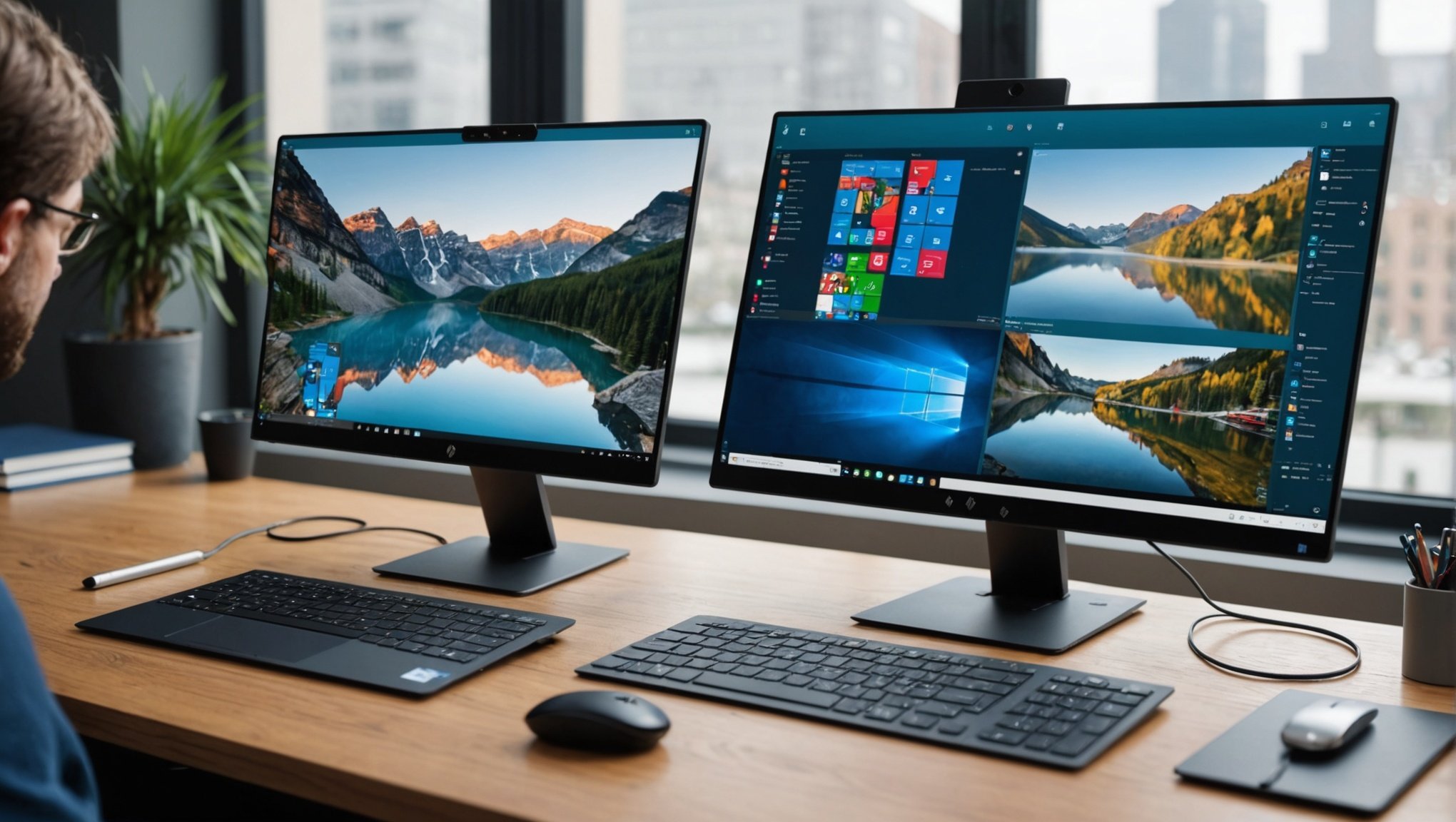The HP Elite Dragonfly is a powerhouse designed for professionals who value mobility without sacrificing performance. As remote work continues to become the norm, the right setup can significantly impact productivity. One of the most effective ways to enhance your home office is by optimizing your HP Elite Dragonfly for use with multiple external displays. This guide will walk you through the steps to achieve a seamless multi-monitor setup, ensuring you can manage your tasks more efficiently and comfortably.
Understanding the Benefits of Multiple External Displays
Multiple external displays can revolutionize your remote workspace. When connected to your HP Elite Dragonfly, they allow you to expand your desktop real estate, seamlessly multitask between applications, and improve your overall productivity. Imagine having one screen dedicated to emails, another for spreadsheets, and a third for video conferencing – the possibilities are endless.
This might interest you : What are the best methods for setting up a virtual private server (VPS) using Proxmox VE on a custom-built server?
Multiple displays reduce the need to switch between tabs and windows constantly, which could lead to less stress and greater efficiency. The HP Elite Dragonfly, with its powerful capabilities, is well-suited for such a setup, providing the flexibility and enhanced performance needed for demanding tasks. By integrating multiple screens, you can tackle complex projects more effectively, whether you’re a designer, developer, or business professional.
Setting Up Your HP Elite Dragonfly for Multiple Displays
Before diving into the technical details, it’s essential to understand the hardware requirements for a multi-display setup. The HP Elite Dragonfly features Thunderbolt 3 ports, which support high-resolution displays and fast data transfer. Here’s a step-by-step guide to ensure a smooth setup.
In parallel : What are the best practices for setting up a secure file sharing system using a Synology DS220+ and Nextcloud?
1. Check Your Ports and Purchase Necessary Adapters
The first step is to identify the types of ports available on your HP Elite Dragonfly. Typically, you’ll find Thunderbolt 3 (USB-C) ports. Depending on the type of external displays you have, you may need adapters. Common adapters include USB-C to HDMI or USB-C to DisplayPort. Ensure you purchase high-quality adapters to avoid connectivity issues.
2. Connect Your Displays
Once you have the adapters, connect your external displays to your HP Elite Dragonfly. Plug the adapter into the Thunderbolt 3 port and then connect the display cable to the adapter. Repeat this process for each additional display.
3. Configure Display Settings
After connecting the displays, you’ll need to configure your display settings. Right-click on your desktop and select “Display settings.” Here, you can arrange the displays in the preferred order, adjust resolution settings, and choose whether to extend or duplicate your screens. For most productivity setups, extending the display is the best option.
4. Optimize Display Arrangement
Properly arranging your displays can significantly impact your workflow. Place the screens side-by-side in the settings menu to match their physical arrangement on your desk. This ensures a natural flow when moving between screens. Additionally, you can set a primary display where your taskbar and primary applications will appear.
Enhancing Performance for a Smooth Experience
Optimizing performance is crucial when working with multiple displays. The HP Elite Dragonfly is equipped with powerful hardware, but there are additional steps you can take to enhance performance and ensure a smooth experience.
1. Update Graphics Drivers
Keeping your graphics drivers up-to-date is essential for optimal performance. Visit the official HP website or use the HP Support Assistant to check for and install the latest graphics drivers. Updated drivers often include performance improvements and bug fixes that can enhance multi-display functionality.
2. Use External GPU (eGPU)
For users who require even more graphical power, an external GPU (eGPU) can be an excellent addition. The HP Elite Dragonfly supports eGPUs through the Thunderbolt 3 port. An eGPU can offload graphics-intensive tasks, providing a significant boost in performance and allowing you to run demanding applications across multiple displays with ease.
3. Manage Power Settings
Managing power settings is vital to ensure your HP Elite Dragonfly runs efficiently when connected to multiple displays. Access the power settings through the control panel and adjust the settings to prioritize performance over energy saving. This will help maintain consistent performance during intensive tasks.
4. Monitor Resource Usage
Keep an eye on your system’s resource usage using the Task Manager. This allows you to identify any applications that may be consuming excessive resources, which can impact performance. Close unnecessary applications and processes to free up system resources and enhance overall performance.
Leveraging Software Tools for Maximum Productivity
In addition to hardware optimizations, software tools can significantly improve your multi-display experience. Here are some must-have applications to consider:
1. DisplayFusion
DisplayFusion is a powerful tool designed to manage multiple monitors. It offers features like customizable monitor profiles, multi-monitor taskbars, and window management shortcuts. With DisplayFusion, you can tailor your multi-display setup to fit your specific needs, enhancing productivity and efficiency.
2. Microsoft PowerToys
Microsoft PowerToys includes a set of utilities to enhance your Windows experience. One essential tool for multi-display setups is FancyZones, a window manager that allows you to create custom layouts for your screens. This can help you organize your applications more effectively, making it easier to multitask across multiple displays.
3. Remote Desktop Software
Remote desktop software is invaluable for remote work. Tools like Microsoft Remote Desktop, TeamViewer, and AnyDesk allow you to access your HP Elite Dragonfly from another device, such as a tablet or smartphone. This can be particularly useful if you need to work on the go but still want to leverage the power of your multi-display setup.
Maintaining Your Multi-Display Setup for Long-Term Use
Once you have your multi-display setup optimized, it’s important to maintain it for long-term use. Regular maintenance ensures that your HP Elite Dragonfly and external displays continue to perform at their best.
1. Regularly Clean Your Displays
Dust and fingerprints can accumulate on your screens, reducing visibility and causing strain on your eyes. Use a microfiber cloth to clean your displays regularly. Avoid using harsh chemicals, as they can damage the screen surface.
2. Manage Cable Clutter
Cable clutter can create a messy and unorganized workspace. Use cable management solutions like cable ties and clips to keep cables tidy. This not only improves aesthetics but also makes it easier to troubleshoot connectivity issues.
3. Monitor Display Health
Keep an eye on the health of your external displays. Look out for signs of screen burn-in, dead pixels, or other issues. Addressing these problems early can prevent them from worsening and affecting your productivity.
4. Backup Your Settings
Consider backing up your display settings and profiles. This can save you time if you need to reset your system or if you accidentally change a configuration. Tools like DisplayFusion often have built-in backup options.
Optimizing your HP Elite Dragonfly for remote work with multiple external displays is a game-changer for productivity. By understanding the benefits, setting up your displays correctly, enhancing performance, leveraging software tools, and maintaining your setup, you can create a highly efficient and comfortable workspace. Whether you’re managing multiple projects, attending virtual meetings, or analyzing data, a multi-display setup can streamline your workflow and help you achieve your professional goals more effectively. Embrace the power of technology and take your remote work experience to the next level with a well-optimized HP Elite Dragonfly.











